Ironworks
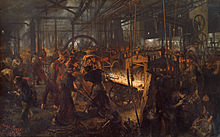
The Iron Rolling Mill (Eisenwalzwerk), 1870s, by Adolph Menzel.

Casting at an iron foundry: From Fra Burmeister og Wain's Iron Foundry, 1885 by Peder Severin Krøyer
An ironworks or iron works is a building or site where iron is smelted and where heavy iron and steel products are made. The term is both singular and plural, i.e. the singular of ironworks is ironworks.
Ironworks succeed bloomeries when blast furnaces replaced former methods. An integrated ironworks in the 19th century usually included one or more blast furnaces and a number of puddling furnaces or a foundry with or without other kinds of ironworks. After the invention of the Bessemer process, converters became widespread, and the appellation steelworks replaced ironworks.
The processes carried at ironworks are usually described as ferrous metallurgy, but the term siderurgy is also occasionally used. This is derived from the Greek words sideros - iron and ergon or ergos - work. This is an unusual term in English, and it is best regarded as an anglicisation of a term used in French, Spanish, and other Romance languages.
Contents
1 Varieties of ironworks
1.1 Primary ironmaking
1.2 Modern steelmaking
1.3 Further processing
1.4 Manufacture
2 Notable ironworks
2.1 Africa
2.1.1 South Africa
2.2 Americas
2.2.1 United States of America
2.3 Asia
2.3.1 China
2.3.2 India
2.3.3 Japan
2.3.4 Korea
2.3.5 Vietnam
2.4 Europe
2.4.1 Czech Republic
2.4.2 Germany
2.4.3 Great Britain
2.4.4 Russia
2.4.5 Spain
2.5 Historical
3 References
Varieties of ironworks
Primary ironmaking
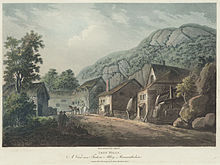
A South Wales iron mill in 1798
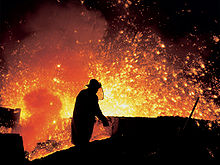
Blast furnaces of Třinec Iron and Steel Works.
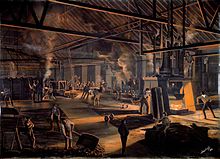
Toronto rolling mills
Ironworks is used as an omnibus term covering works undertaking one or more iron-producing processes.[1] Such processes or species of ironworks where they were undertaken include the following:
Blast furnaces — which made pig iron (or sometimes finished cast iron goods) from iron ore;
Bloomeries — where bar iron was produced from iron ore by direct reduction;
Electrolytic smelting — Employs a chromium/iron anode that can survive a 2,850 °F (1,570 °C) to produce decarbonized iron and 2/3 of a ton of industrial-quality oxygen per ton of iron. A thin film of metal oxide forms on the anode in the intense heat. The oxide forms a protective layer that prevents excess consumption of the base metal.[2]
Finery forges — which fined pig iron to produce bar iron, using charcoal as fuel in a finery (hearth) and coal or charcoal in a chafery (hearth);
Foundries — where pig iron was remelted in an air furnace or in a foundry cupola to produce cast iron goods;
Potting and stamping forges with melting fineries using the first process in which bar iron was made from pig iron with mineral coal or coke, without the use of charcoal;
Puddling furnaces — a later process for the same purpose, again with coke as fuel. It was usually necessary for there to be a preliminary refining process in a coke refinery (also called running out furnace). After puddling, the puddled ball needed shingling and then to be drawn out into bar iron in a rolling mill.
Modern steelmaking
From the 1850s, pig iron might be partly decarburised to produce mild steel using one of the following:[3]
- The Bessemer process in a Bessemer converter, improved by the Gilchrist-Thomas process;
- The Siemens-Martin process in an Open hearth furnace;
Electric arc furnace, introduced in 1907;
Basic oxygen steelmaking, introduced in 1952.
The mills operating converters of any type are better called steelworks, ironworks referring to former processes, like puddling.
Further processing
After bar iron had been produced in a finery forge or in the forge train of a rolling mill, it might undergo further processes in one of the following:
- A slitting mill - which cut a flat bar into rod iron suitable for making into nails.
- A tinplate works - where rolling mills made sheets of iron (later of steel), which were coated with tin.
- A plating forge with a tilt hammer, a lighter hammer with a rapid stroke rate, enabling the production of thinner iron, suitable for the manufacture of knives, other cutlery, and so on.
- A cementation furnace might be used to convert the bar iron (if it was pure enough) into blister steel by the cementation process, either as an end in itself or as the raw material for crucible steel.
Manufacture
Most of these processes did not produce finished goods. Further processes were often manual, including
- Manufacturing by blacksmiths or more specialist kind of smith.
- It might be used in shipbuilding.
In the context of the iron industry, the term manufacture is best reserved for this final stage.
Notable ironworks
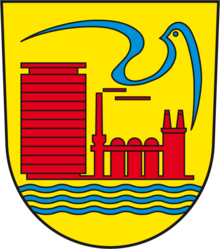
Coat of arms of Eisenhüttenstadt ("city of ironworks"), Germany
The notable ironworks of the world are described here by country. See above for the largest producers and the notable ironworks in the alphabetical order.
Africa
South Africa
- Cape Town Iron and Steel Works in Kuilsrivier, Western Cape
Americas
United States of America
American Iron Works in Hyattsville, Maryland
Bath Iron Works in Maine
Burden Iron Works in Troy, New York
Cambria Iron Company in Johnstown, Pennsylvania
Falling Creek Ironworks, Virginia.
Saugus Iron Works in Saugus, Massachusetts
Toledo Iron Works in Miami, Florida
Tredegar Iron Works at Richmond, Virginia
U.S. Steel
Fairfield Works, near Birmingham, Alabama
Gary Works, near Chicago, Illinois
Granite City Works, near St. Louis, Missouri
Great Lakes Works, near Detroit, Michigan
Mon Valley Works (Homestead Steel Works, etc.), near Pittsubutgh, Pennsylvania
Vulcan Iron Works in Pennsylvania and other places
Asia
China
Anben Group, Anshan & Benxi, Liaoning
Baosteel, Shanghai
Baotou Steel, Baotou, Inner Mongolia
Shougang Group, Beijing
Wuhan Steel, Wuhan, Hebei
India
Five major steel works of Steel Authority of India, Ltd (SAIL)
Kalinganagar Works of Tata Steel in Kalinganagar, Odisha
Vijayanagar Works of JSW Steel in Bellary, Karnataka
Japan
The largest Japanese steel companies' main works are as follows:
JFE Steel
Chiba Works (from former Kawasaki Steel), Chiba, Chiba, of JFE Eastern Works
Keihin Works (from former NKK), Kawasaki, Kanagawa, of JFE Eastern Works
Fukuyama Works (from former NKK), Fukuyama, Hiroshima, of JFE Western Works
Kurashiki Works (from former Kawasaki Steel), Kurashiki, Okayama, of JFE Western Works
Kobe Steel
Kakogawa Steel Works, Kakogawa, Hyogo
Nippon Steel & Sumitomo Metal
Hirohata Works (広畑製鐵所, of former Nippon Steel), Himeji, Hyogo
Kimitsu Steel Works, of former Nippon Steel), Kimitsu, Chiba
Nagoya Works (名古屋製鐵所, of former Nippon Steel), Tokai, Aichi (near Nagoya)
Ōita Works (大分製鐵所, of former Nippon Steel), Ōita, Ōita
Yawata Steel Works (of former Nippon Steel), Kimitsu, Chiba
Kashima Works (鹿島製鐵所, of former Sumitomo Metal), Kashima, Ibaraki
Wakayama Works (和歌山製鐵所, of former Sumitomo Metal), Wakayama, Wakayama
Korea
POSCO
Gwangyang Steelworks, south coast
Pohang Steelworks, east coast
Hyundai Steel
Incheon Steelworks, west coast
Vietnam
Formosa Ha Tinh Steel of Formosa Plastics Group in Ha Tinh Province
Europe
Czech Republic
Třinec Iron and Steel Works in Třinec, Czech Republic
Germany
Völklingen Ironworks Heritage Site
Great Britain
Blaenavon Ironworks Heritage Site. Blaenavon (Blaenafon) South Wales
Coalbrookdale Ironworks, Coalbrookdale
Cyfarthfa Ironworks at Merthyr Tydfil, Glamorgan, south Wales
Dowlais Ironworks also at Merthyr Tydfil
Millwall Ironworks, a shipbuilding firm on the Isle of Dogs, on the River Thames, London, England
Thames Ironworks and Shipbuilding Co. Ltd, a shipbuilding firm at Leamouth on the River Thames, England
Vulcan Iron Works at Bradford and other places
Russia
Chelyabinsk Tube Rolling Plant, Chelyabinsk, Chelyabinsk Oblast
Magnitogorsk Iron and Steel Works, Magnitogorsk, Chelyabinsk Oblast
Nizhny Tagil Iron and Steel Works, Nizhny Tagil , Sverdlovsk Oblast
Novokuznetsk Iron and Steel Plant (of TMK), Novokuznetsk, Kemerovo Oblast
Novolipetsk Steel, Lipetsk, Lipetsk Oblast
Severstal, Cherepovets, Vologda Oblast
Ural Steel (of Metalloinvest), Novotroitsk, Orenburg Oblast
- Volzhsky Pipe Plant (of OAO TMK), Volzhsky, Volgograd Oblast
Spain
Altos Hornos de Vizcaya in Bilbao
Arcelor facilities in Avilés and Gijón, formerly Ensidesa
Historical
Kindiba, in Burkina Faso. Ancient iron extraction site consisting of mines and three clay built furnaces.
Darkhill Ironworks, in the Forest of Dean, England. Experimental ironworks established in 1818 and designated an 'Industrial Archaeological Site of International Importance'
Royal Ironworks of St John, Ipanema, in São Paulo state, Brazil
References
| Wikimedia Commons has media related to Ironworks. |
^ Hayman, Richard (2005). Ironmaking: History and Archaeology of the British Iron Industry. History Press..mw-parser-output cite.citation{font-style:inherit}.mw-parser-output q{quotes:"""""""'""'"}.mw-parser-output code.cs1-code{color:inherit;background:inherit;border:inherit;padding:inherit}.mw-parser-output .cs1-lock-free a{background:url("//upload.wikimedia.org/wikipedia/commons/thumb/6/65/Lock-green.svg/9px-Lock-green.svg.png")no-repeat;background-position:right .1em center}.mw-parser-output .cs1-lock-limited a,.mw-parser-output .cs1-lock-registration a{background:url("//upload.wikimedia.org/wikipedia/commons/thumb/d/d6/Lock-gray-alt-2.svg/9px-Lock-gray-alt-2.svg.png")no-repeat;background-position:right .1em center}.mw-parser-output .cs1-lock-subscription a{background:url("//upload.wikimedia.org/wikipedia/commons/thumb/a/aa/Lock-red-alt-2.svg/9px-Lock-red-alt-2.svg.png")no-repeat;background-position:right .1em center}.mw-parser-output .cs1-subscription,.mw-parser-output .cs1-registration{color:#555}.mw-parser-output .cs1-subscription span,.mw-parser-output .cs1-registration span{border-bottom:1px dotted;cursor:help}.mw-parser-output .cs1-hidden-error{display:none;font-size:100%}.mw-parser-output .cs1-visible-error{font-size:100%}.mw-parser-output .cs1-subscription,.mw-parser-output .cs1-registration,.mw-parser-output .cs1-format{font-size:95%}.mw-parser-output .cs1-kern-left,.mw-parser-output .cs1-kern-wl-left{padding-left:0.2em}.mw-parser-output .cs1-kern-right,.mw-parser-output .cs1-kern-wl-right{padding-right:0.2em}
^ 9 May 2013 (2013-05-09). "A new iron age?". The Why Files. Retrieved 2014-02-06.
^ Ghosh, Ahindra; Chatterjee, Amit (2008). Ironmaking and Steelmaking: Theory and Practice. Prentice-Hall of India.
